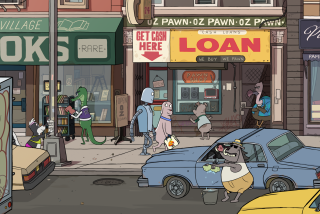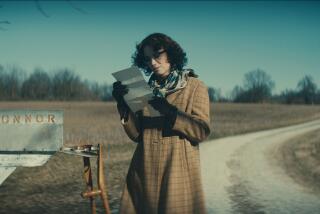‘Wolfwalkers’ wraps a story of a unique friendship around troubling Irish history
In the 1650s Ireland of “Wolfwalkers,” a city girl from England and a feral “wolfwalker” child become friends as an Oliver Cromwell-type Lord Protector tries to wipe out all wolves in the country. But Irish co-directors Tomm Moore and Ross Stewart have a lot to say under cover of that animated-adventure plot.
“Cromwell viewed Ireland as being a wild land full of rebels that lived in the forest, ready to attack, and there were wolves there. And the fact that the Irish people believed in the stories of wolf people, all these fairies and legends ... he would have seen it as another reason to completely ‘civilize’ this country,” Stewart said.
Moore takes that idea even deeper. “The stories we were telling in Ireland were a threat to the story of the expanding British Empire, and so they needed to squash that way of seeing the world. They extinguished the wolves and fairly well extinguished that belief system. The connections to a lot of those stories have died off. And that’s why we sort of thought it was important to reimagine the stories for another generation, because we are the stories we tell ourselves about ourselves, for better or worse.”
Cartoon Saloon, the Irish animation studio that scored Oscar nominations for each of its three previous features, is back with “Wolfwalkers.” Its directors sat down for an Envelope Screening Series Q&A.
“He cut down massive swaths of Irish woodlands because that’s where there were rebels and where wolves lived; he wanted to turn it all into productive farmland. He wanted to organize everything,” added Stewart. “So there was this huge environmental destruction as well. We have actually the lowest rate of forest cover of any European country. It hasn’t been allowed to regenerate since then. So that’s why we wanted to focus particularly on Oliver Cromwell as the bedrock for the Lord Protector character; he goes down as being like the villain of Irish history.”
While most Americans may be unaware of that historical backdrop, it sets the stage for the meeting of “Wolfwalkers’” main characters: responsible Robyn Goodfellowe and feral Mebh. Their names seem switched: Robin Goodfellow, of course, is another name for Puck, the mischievous forest spirit from Shakespeare’s “A Midsummer Night’s Dream,” and Maeve was a queen, albeit the warrior queen, of Connacht in the western part of Ireland.
“Robyn’s on a journey to being a bit more like Mebh, and Mebh needs to be a bit more like Robyn, so they were kind of in two different directions,” said Moore.
“I always loved their interaction when they first meet; there’s a long scene of them kind of arguing, and Mebh is trying to hold in her temper. There’s kind of a back and forwards, and it’s really fun,” Moore said. “And then whenever Mebh is telling the wolves to follow Robyn, there’s a moment where she goes, ‘Come on, come on, what’re you doing?’ It was funny drawing in the storyboard, and it made it all the way in, and it still gets a laugh.
“I love the way Eva Whittaker, who plays Mebh, in that moment, goes, ‘They’re gon’ta eat ya! Too late, they’re gon’ta eat ya!’ She said that in her audition; that was a clincher.”
Stewart added, “One thing that gives me a little bit of a chill is Mebh’s moment up on the wall when she roars at all of the townspeople and she has the big, red, setting sun behind her, and she’s like, ‘I’m gonna come back here and I’m gonna eat you all!’”
The movie’s visuals are justly celebrated. You could freeze most frames and they would look like pages from a gorgeously painted storybook. Stewart noted that what appears to be “globby and loose,” especially in the lush depictions of nature, actually took much careful planning, scripting of color gradation and the like. That planning is also evident in the geometry the artists used to differentiate the human world, with its hard lines and right angles, from the flowing, wavy curviness of the sumptuous forest.
“There’s two long vertical crane shots,” Moore pointed out. “Robyn first steps into the town, and we go all the way up through the streets back to the castle, and it’s really blocky and woodblock print, and everything is cagelike, in squares; and when she discovers the ravine in the forest, we do the same kind of a crane shot up to the waterfall, but everything’s Andy Goldsworthy structures, land art — everything else is just curves in nature.”
“No. 7 Cherry Lane,” “Kill It and Leave This Town” and “On-Gaku: Our Sound” are among the idiosyncratic, personal animated works this season.
Stewart pointed out further distinctions. “When Robyn has to work, knowing Mebh is out there waiting for her on the tree, and Bill [Robyn’s father] is being ordered by the Lord Protector to build that big stage ... There’s a triptych: Bill is working, and everything is so perfectly geometric and square, and Robyn is in the middle and she’s completely trapped, the whole cage around her. Mebh is on this tree with this lovely, beautiful kind of spirally loop. In the one image, you’ve got this juxtaposition of the outside world with its freedom and its flowing curves, and the two other characters completely caged in.
“The fact that Lord Protector is ordering [people around], it’s a good symbol, because that’s ultimately his aim: To turn all of these untamed curves into nice, ordered little geometric boxes.”
But are these messages being received?
“What I find really encouraging is young teenagers who seem to tap into this sense of Robyn becoming the person that she needs to be, even if it means going against society or the wishes of her father,” Stewart said. “So there’s that sense of finding yourself, and whether that’s an LGBT thing or someone wants to break out of their conservative society or whatever, young teenagers are kind of tapping into that.”
Moore found other rewards in the film’s warm reception. “Twitter is usually this hellscape of people arguing about politics, and to have a little 7-year-old pop up on your feed and say, ‘I loved your movie and I want to draw wolves now’ ... This is great.”
Our BuzzMeter film experts predict the 2021 Oscar winners. You can vote, too - polls are open in all 10 categories they pick.
More to Read
From the Oscars to the Emmys.
Get the Envelope newsletter for exclusive awards season coverage, behind-the-scenes stories from the Envelope podcast and columnist Glenn Whipp’s must-read analysis.
You may occasionally receive promotional content from the Los Angeles Times.







